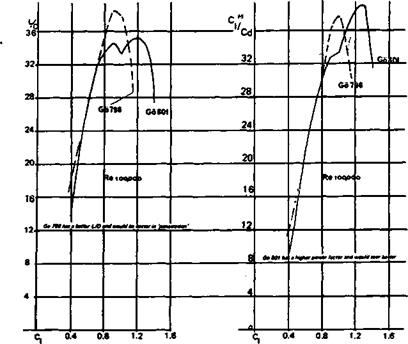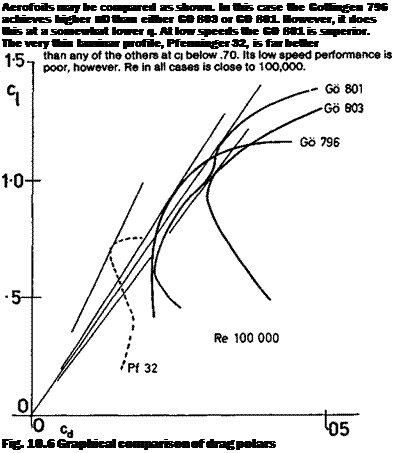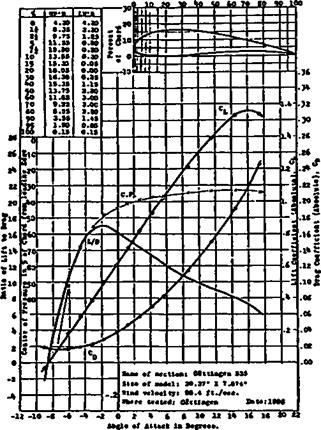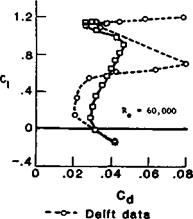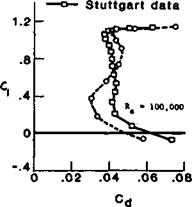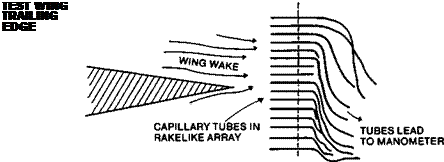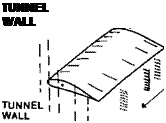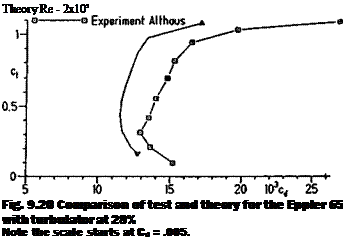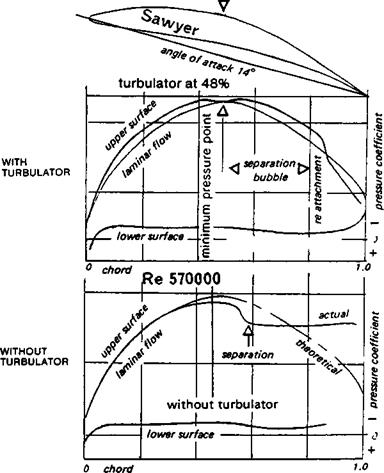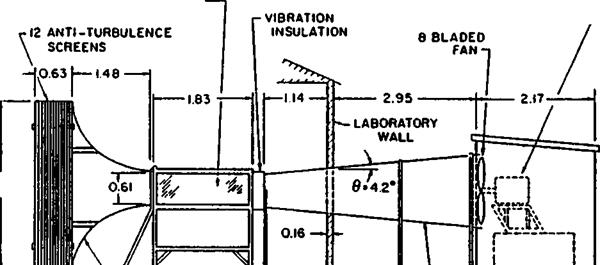Early wind tunnel test charts were usually very simple, showing how the lift coefficient and drag coefficient varied with angle of attack. The pitching moment was used as a basis. for calculation of the abstract centre of pressure movement, as described in 7.12. The wind tunnels were usually of the open working section type. The models were of low aspect ratio. The size and shape of die test piece were usually stated on the results chart, so corrections for different aspect ratios were left to the aircraft designer. For several decades, every wind tunnel in die world had its own conventions and methods of plotting, so there was great confusion. In an effort to bring order, the NACA during the 1920s published a great series of reports which consisted of collected wind tunnel results from all over the world, reduced to standard form and plotted on a standard type of graph. An example is given in Figure 10.5. Charts from this era still crop up from time to time in the modelling press, because the sizes and flow velocities are sometimes comparable with model Re numbers. Unfortunately, these early results cannot be regarded as reliable now. The test methods used were relatively unrefined, and every tunnel was different (NACA and the Royal Aircraft Establishment at Famborough actually exchanged wind tunnel models across the Atlantic, to see whether they would produce similar results when tested in two of the best wind tunnels available. The outcome caused great concern at the time, for there was little agreement It was after this that the importance of Reynolds number and tunnel turbulence began to be recognised.)
Modem tunnel results are almost always plotted in a standard fashion, similar to that used in this book, although minor differences still appear. (See Figure 10.4 and Appendix 2). Most importantly, the measurements are given for the aspect ratio of infinity. That is, if the wind tunnel model did not actually span the test section completely, the results are still presented after correction for the theoretical infinite state. In this respect, the designer choosing a wing section does not have to worry about variations of tip vortex drag. No vortex drag is supposed to appear in the wind tunnel results. This does of course mean the designer must make suitable corrections once the wing aspect ratio and planform have been decided, but the aerofoil data can be studied without this factor at first. Such wind tunnel data is described as ‘two dimensional’ because the airflow in the tunnel, or after correction, is without lateral motions. (The occurrence of tiny vortices chordwise in the boundary layer after a separation bubble does invalidate this slightly but these vortices are quite different in origin, and effect, from the large wing tip vortices of a finite wing.)
The section lift coefficient, ci, is plotted against angle of attack. Where the ci curve crosses the zero line is the aerodynamic zero and in the case of cambered section this is always at some negative angle, geometrically. The section drag coefficient, cd, is plotted in its turn against ci. The same vertical scale of ci is used for both drag and lift, so it is perfectly straightforward to read from the angle of attack up to the ci, and horizontally across to the Cd curve, whose scale is horizontal at the bottom of the chart.
The pitching moment coefficient is plotted on the same graph as the ci curve or sometimes on its own separate part of the chart, but always easily and directly related to the ci curve. It is particularly important to remember that the cm of cambered profiles is negative (nose down) at all normal angles of attack. Conventions still vary between different laboratories as to whether the cm scale reads upwards towards the more negative values or downwards, and when the scale is arranged horizontally, whether the negative values appear on the left or the right. The pitching moment is not usually expressed as centre of pressure movement now.
All modem wind tunnel measurements are taken at the 25% chord position on the test model, or are subsequently corrected to this location before the charts are plotted. With full scale aerofoils this almost always produces a cm of constant value at all usable angles of attack (i. e. below the stalling region). If the true aerodynamic centre of the aerofoil is slightly out of the 25% position, which does happen sometimes, the cm plot will still, as a rule, be a straight line over the flying range of q, but the line will slope down at some small angle instead of showing a constant value. This does not mean that the moment coefficient actually varies, but only that the aerodynamic centre is either slightly ahead of, or behind the expected 25% point It may also be slightly above or below the centre camber line which has the same effect on the charts. If the cm line slopes from a high negative value at low ci to a less negative value at high ci, the aerodynamic centre lies ahead of the 25% point and conversely, if the Сщ curve slopes from low negative at low ci to high negative at high ci, the a. c. is somewhat aft of 25%. Some wind tunnel test results report the exact a. c. position. Departures from 25% of a few decimal points are in practice hardly enough to matter.
With model-sized measurements, as previously noted, the movements, lengthenings and shortenings of the laminar separation bubbles cause the moment coefficient curves to wander a little. Even so, it is nearly always possible to show that, over the usable range of q and angles of attack, a part at least of the cm curve is more or less straight, although it may be sloping. As before, the direction of the slope indicates whether the aerodynamic centre is ahead of or behind the 25% point So far, when the cm has been measured at all, the indications are that the a. c. centre of model wing profiles is always, as with full sized aircraft, very close to 25% of the chord.
The profiles most likely to depart from these generalisations are the very thin, highly cambered types used on indoor flying models and on small free-flight aircraft Very little reliable test work has been done on these and some of the moment coefficient curves published in recent times are now though to have been wrongly plotted. F. W. Schmitz’s early measurements of the curved plate sections (see Appendix 2) and those by Kraemer of the Gottingen 803 and 804 indicate quite large departures from the straight line cm curves, although even here some parts of the plot are nearly straight, indicating a fixed aerodynamic centre over a certain range of trims (e. g. on the Gd 803 between ci 0.5 and 1.5, at Re 100,000 and 150,000). Where separation bubbles of great length occur, or where flow separation takes place on an even larger scale, standard theory breaks down and there is, as yet, no alternative but to rely on experience with these very thin profiles. To test a microfilm model wing in any normal wind tunnel would in any case be impossible.
It is also worth noting that a profile which behaves badly at very low Re in the smooth and polished condition can often be greatly improved and stabilised by the use of turbulators. The Go 803 tests with the turbulator show a fixed aerodynamic centre for this profile, at 150,000 Re, between q 0.4 and 1.5, at 25% chord, and this apparently applies also to the lower Re of 50,000.











